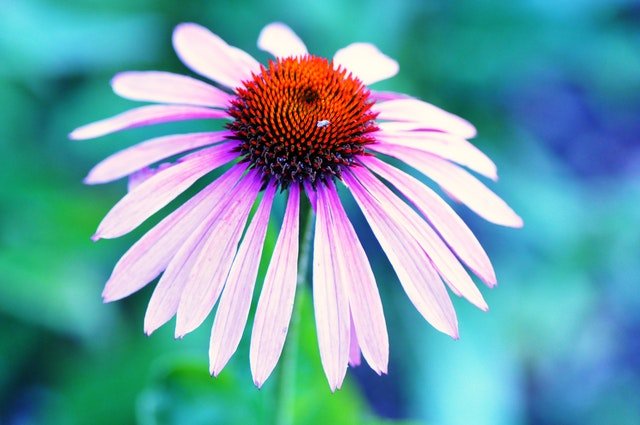
Echinacea, Echinacea by its scientific name, is a plant to which endless medicinal properties are attributed. In fact, the indigenous tribes of North America, where it originates from, used the infusion of echinacea to treat bites, poisons and bacterial diseases.
Currently, alternative medicine recommends its consumption as a natural antibiotic to fight infections. Next, you will discover everything about this plant and, specifically, about the infusion of echinacea.
The echinacea plant
This plant belongs to the asteraceae family (Asteraceae). There are 23 varieties, of which less than half are suitable for human consumption. Among the most famous are the narrow-leaved echinacea (angustifolia), the pallida and the echinacea purpurea. The latter is the one considered “most effective”.
All three are used to treat the symptoms of respiratory infections, as well as to relieve bacterial or viral illnesses and topically on cuts and bites.
Although all parts of this plant are used (leaves, seeds, flowers, roots and even stems), echinacea infusion or tea, whatever its variety, is usually prepared with the tincture or with plant root.
Its root exhibits a deep black color and has a pungent flavor somewhat reminiscent of ginger.
Health benefits of echinacea tea
Natural medicine experts point out that echinacea contains vitamins C and B, riboflavin, beta-carotene and minerals such as calcium, iron, magnesium and sodium.
Now, what is the use of drinking this infusion?
Helps cure cold and flu
A 2007 investigation by the Journal of Herbal Pharmacotherapy noted that echinacea is a natural antibiotic that helps relieve cold and flu symptoms. So, you know, keep echinacea on hand this fall and winter.
Antifungal, antibacterial and antiviral properties
The Chinese Journal of Chemical Engineering conducted an extensive study on the use of echinacea and its health properties. Throughout this research, its antifungal, antibacterial, and antiviral properties were corroborated.
In this way, drinking an infusion of echinacea could help combat halitosis or bad breath, since it would be responsible for eliminating the bacteria that cause it. On the other hand, it would act against the germs that generate throat diseases, such as laryngitis and pharyngitis, among others.
Antioxidant effect
It has also been possible to determine that this plant has antioxidant properties. In other words, some of its components, such as vitamin C and beta carotene, fight free radicals, preventing the oxidative stress that ends up generating the appearance of certain degenerative diseases and also premature aging.
Improves allergy symptoms
It is believed that drinking echinacea infusion helps to improve the annoying symptoms associated with respiratory allergies, as well as those caused by sinusitis and bronchitis, and even more serious diseases such as COPD (chronic obstructive pulmonary disease).
Keep in mind that consuming echinacea infusion does not exempt you from visiting the doctor to receive a timely diagnosis and treatment.
Helps strengthen the immune system
The vitamin C content of this plant helps improve the body’s defenses and allows the body to better protect itself against common diseases such as shingles, styes, and infections (vagienal, urinary, and ear).
Combat fatigue
Ayurvedic medicine specialists maintain that consuming echinacea helps prevent chronic fatigue and overcome it when it occurs.
Promotes digestion
Another of the widespread uses of echinacea is to stimulate the appetite. On the other hand, it is believed that its intake helps to generate saliva and, therefore, would contribute to a good digestion of food.
It is anti-inflammatory
Echinacea can be used orally or topically; In both ways, it would act to improve the inflammatory discomfort caused by diseases such as tendinitis, bursitis or arthritis. In addition, it would serve to combat migraine.
How to prepare an infusion of echinacea

Preparing the echinacea infusion is not difficult at all. In fact, you can use both the root and the leaves, or even the tincture. It all depends on what you can get in your trusted herbalist.
Ingredients
- 2 half-centimeter pieces of dried echinacea root / 2 tablespoons of clean leaves
- 1 cup of water
Elaboration
- Bring the water to a boil.
- If you have the root, put it in the kettle or pot and let it decoction for 5 minutes. Turn off the heat and let stand 3 more minutes before straining and serving.
- In the case of having leaves at home, wash them well. Submerge them in the boiling water and let stand off the heat for 4 minutes.
- You can sweeten with honey if you wish.
Note: Echinacea tea can also be prepared with a tincture. Consult your trusted herbalist about the necessary amounts.
Benefit from the properties of echinacea infusion. You will see that it is tasty and very good for health. Of course, if you are pregnant, breastfeeding or have liver disease, consult your doctor before starting to take it.
